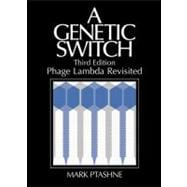
What is included with this book?
| Preface to the Third Edition, | xi | ||||
| Preface to the First Edition, | xiii | ||||
| INTRODUCTION | 1 | (10) | |||
| CHAPTER ONE THE MASTER ELEMENTS OF CONTROL | 11 | (20) | |||
|
14 | (4) | |||
|
14 | (1) | |||
|
15 | (1) | |||
|
16 | (1) | |||
|
17 | (1) | |||
|
18 | (4) | |||
|
18 | (1) | |||
|
18 | (2) | |||
|
20 | (2) | |||
|
22 | (4) | |||
|
26 | (2) | |||
|
28 | (1) | |||
|
28 | (3) | |||
| CHAPTER TWO PROTEIN-DNA INTERACTIONS AND GENE CONTROL | 31 | (16) | |||
|
31 | (3) | |||
|
34 | (3) | |||
|
37 | (2) | |||
|
39 | (4) | |||
|
43 | (1) | |||
|
44 | (3) | |||
| CHAPTER THREE CONTROL CIRCUITS-SETTING THE SWITCH | 47 | (20) | |||
|
48 | (4) | |||
|
48 | (1) | |||
|
49 | (1) | |||
|
50 | (1) | |||
|
51 | (1) | |||
|
52 | (4) | |||
|
52 | (1) | |||
|
52 | (1) | |||
|
53 | (2) | |||
|
55 | (1) | |||
|
56 | (1) | |||
|
57 | (3) | |||
|
58 | (1) | |||
|
58 | (1) | |||
|
58 | (2) | |||
|
60 | (1) | |||
|
60 | (2) | |||
|
62 | (5) | |||
|
62 | (1) | |||
|
63 | (1) | |||
|
64 | (3) | |||
| CHAPTER FOUR HOW DO WE KNOW-THE KEY EXPERIMENTS | 67 | (42) | |||
|
67 | (4) | |||
|
67 | (2) | |||
|
67 | (1) | |||
|
68 | (1) | |||
|
69 | (1) | |||
|
69 | (1) | |||
|
70 | (1) | |||
|
70 | (6) | |||
|
70 | (1) | |||
|
71 | (1) | |||
|
71 | (1) | |||
|
72 | (2) | |||
|
74 | (2) | |||
|
76 | (27) | |||
|
76 | (1) | |||
|
76 | (2) | |||
|
78 | (6) | |||
|
78 | (2) | |||
|
80 | (2) | |||
|
82 | (2) | |||
|
84 | (2) | |||
|
84 | (1) | |||
|
85 | (1) | |||
|
85 | (1) | |||
|
86 | (1) | |||
|
87 | (5) | |||
|
92 | (2) | |||
|
92 | (1) | |||
|
93 | (1) | |||
|
94 | (1) | |||
|
94 | (1) | |||
|
95 | (1) | |||
|
95 | (4) | |||
|
95 | (1) | |||
|
96 | (2) | |||
|
98 | (1) | |||
|
99 | (1) | |||
|
99 | (10) | |||
|
99 | (3) | |||
|
102 | (1) | |||
|
103 | (6) | |||
| CHAPTER FIVE 2004: NEW DEVELOPMENTS | 109 | (42) | |||
|
109 | (13) | |||
|
110 | (2) | |||
|
112 | (1) | |||
|
113 | (9) | |||
|
113 | (1) | |||
|
114 | (1) | |||
|
114 | (1) | |||
|
115 | (7) | |||
|
122 | (9) | |||
|
122 | (1) | |||
|
123 | (1) | |||
|
123 | (8) | |||
|
123 | (2) | |||
|
125 | (1) | |||
|
125 | (1) | |||
|
125 | (2) | |||
|
127 | (4) | |||
|
131 | (2) | |||
|
132 | (1) | |||
|
133 | (3) | |||
|
133 | (1) | |||
|
134 | (1) | |||
|
134 | (2) | |||
|
136 | (15) | |||
| Index | 151 |
The New copy of this book will include any supplemental materials advertised. Please check the title of the book to determine if it should include any access cards, study guides, lab manuals, CDs, etc.
The Used, Rental and eBook copies of this book are not guaranteed to include any supplemental materials. Typically, only the book itself is included. This is true even if the title states it includes any access cards, study guides, lab manuals, CDs, etc.